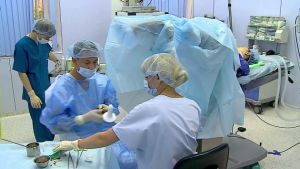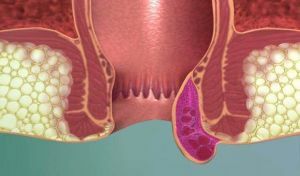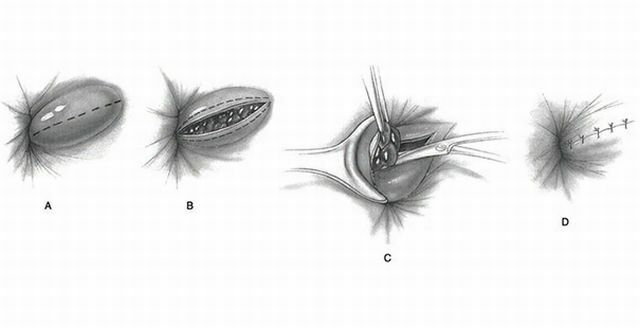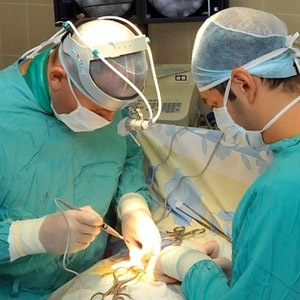 Hemorrhoids in the absence of timely and proper treatment can lead to quite dangerous and unpleasant consequences, one of which is thrombosis of the hemorrhoids.
Hemorrhoids in the absence of timely and proper treatment can lead to quite dangerous and unpleasant consequences, one of which is thrombosis of the hemorrhoids.
What is it, and what treatments can there be? According to experts, such a thrombosis has only one option for removal: thrombectomy of the hemorrhoidal node.
Contents
- Features of thrombosed hemorrhoids
- When operation
- is required Indications and contraindications for intervention
- Patient preparation
- How is operation
- Postoperative period
- Possible complications after operation
- Cost of procedure
Features of thrombosed hemorrhoids
Hemorrhoidal thrombosed node represents a danger to the patient in the form of infectionblood.
The cause of thrombosis is the neglect of the disease.
To fully understand the pathogenesis of the presented disease, the sequence of thrombus formation should be considered.
Gradually, as the disorder develops, the following processes occur:
- In the 3 or 4 stages of hemorrhoids, the patient begins to notice how his began to drop hemorrhoidal nodes from the anal
 aperture.
aperture. - If you do not take measures in time and do not correct the fallen node from the anus, forms its pinching , in which the sphincter muscles participate.
- Because of a pinch, is a circulatory disorder of , which subsequently provokes the formation of a blood clot in the hemorrhoidal node. A clot is called a thrombus - a consequence of impaired blood circulation and nutrition.
After the formation of the thrombus, the patient feels an intolerable sharp pain that prevents a person from walking and sitting. The following features are also highlighted:
- node acquires a dark purple hue;
- there is swelling of the sphincter;
- mucus with an unpleasant odor appears near the anal opening;
- a simple visit to the toilet leads to suffering, often the patient simply does not emptied the intestines;
- is an intoxication of the body in the form of chills, headaches and fever.
When operation
is necessary As treatment for a patient who is in this condition, at the initial stage a conservative treatment is appointed in the form of the use of medications - analgesics, antispasmodics.
But, as a rule, such treatment does not lead to a complete cure of the thrombosed hemorrhoidal node. The only solution is surgical intervention in the form of a thrombectomy.
The procedure is the removal of the hemorrhoidal node from the lumen. Such a surgical intervention can only alleviate the suffering of the patient, therefore, it is not an integrated cure for all hemorrhoids.
The operation is performed on an outpatient basis or in a proctologist's office at a polyclinic. No special preparatory actions and long-term recovery is required.
Indications and contraindications for
 intervention This procedure is carried out in most cases on patient complaints in unbearable pain.
intervention This procedure is carried out in most cases on patient complaints in unbearable pain.
So, at the initial stage, the specialists begin the general conservative treatment - pain elimination, edema removal, possible elimination of the hemorrhoidal node jamming and its subsequent repositioning in the anus.
Typically, this treatment can take a long time, often up to several weeks. The most depressing is the ineffectiveness of conservative methods, as well as the serious suffering of the patient.
Despite the fact that with the help of thrombectomy it is possible to quickly alleviate the patient's condition, the presented operation has its contraindications to the procedure, among which are:
- the patient's dying condition;
- in the case of diagnosing a depleted patient;
- presence of sepsis.
Patient preparation
Any operation to remove hemorrhoids requires complete cleansing of the intestine. Here the patient suffers with similar procedures, because he can not empty himself due to severe pain.
As a result, the methods of cleansing the intestine in each case are selected individually depending on the patient's condition.
There are two ways to cleanse the intestines: taking laxatives or carrying out cleansing enemas. The first method is performed the day before the operation. The second 2-3 hours before thromboectomy.
How is the operation
The technique is as follows:
- The operation does not require general anesthesia, it costs local anesthesia, so at the initial stage an anesthetic is injected into the thrombosed unit.
- After the anesthetic has worked, you can start the operation. At the node, make a small incision so that it can be used to remove the thrombus.
- Through an incision with the help of natural blood circulation the thrombus leaves by itself, but sometimes it is carried out by surgical instruments.
- Almost immediately you can see how the patient slept swelling. After a while, when the anesthesia ceases to operate, the patient will gradually feel a decrease in the intensity of the pain, and after a couple of days the inflammation will completely pass.
- The wound is not stitched from the incision - it does not heal itself more than a week after the operation. For its early healing, bandages are applied with solutions, which are replaced after each trip to the toilet.

Thrombectomy is the best and quickest way to eliminate a thrombosed hemorrhoidal node. Therefore, in most cases, proctologists are advised to perform an operation if the patient already had swelling and inflammation.
How is hemorrhoids thrombectomy, carefully the video is very natural:
Postoperative period
After the operation, the patient is released home after 15 minutes. He is not issued a sick leave sheet, because the ability of  to walk and carry out standard movements and actions remains unchanged.
to walk and carry out standard movements and actions remains unchanged.
Doctors-proctologists give a full instruction on the care of the wound until it is fully healed.
So, a sterile gauze bandage is applied after each visit to the toilet or daily, if in the first days after cleansing the bowel there will be no stool.
In some cases, wound dressing or a solution is applied to the dressing, although often everything is treated with a simple clean gauze.
In order not to give yourself pain while visiting the toilet until the wound is completely healed, the patient should follow a diet where there will be liquid and cushy dishes, sour-milk products, fruits and vegetables.
Possible complications after operation
After the operation, most complications are not observed. The only thing that the patient can complain about is the pain in the first days after the operation.
If they are noted, it means that you can use any pain medication approved for use by a specialist.
Cost of procedure
Thrombectomy in Russia is a paid operation, the price varies from 2 to 5 thousand rubles.
An important feature is the fact that the thrombosed node reappears due to the absence of medical treatment for hemorrhoids.
Also often, patients after the operation return to the old rhythm of life - days on end, the use of harmful products and alcohol.
This behavior will lead to a new prolapse of the hemorrhoidal node and its subsequent jamming. Therefore, we should radically reconsider our habitual way of life and make appropriate changes.
